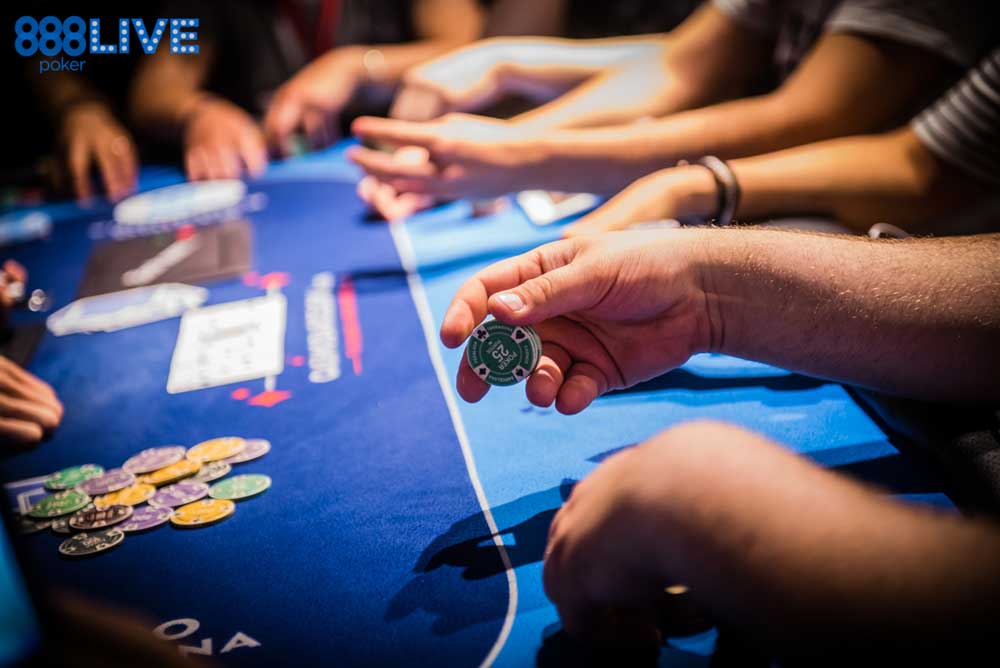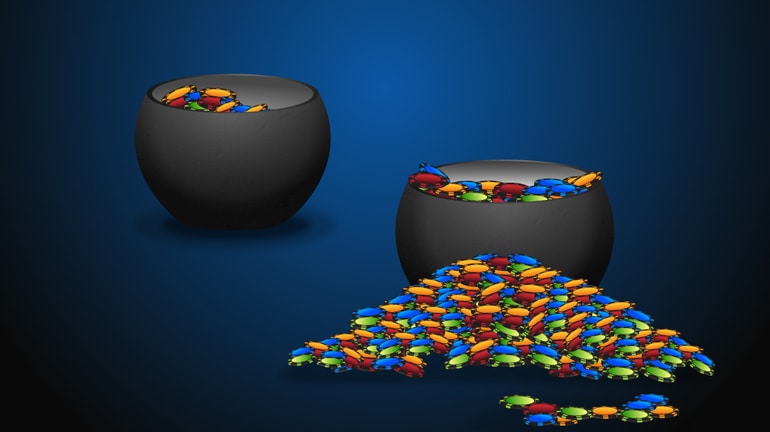Recently, many of us moved from playing live in casinos and home games to online poker.
Much can be written about the differences between playing online versus playing live.
These differences include the following –
- Physical tells
- The possibility of collusion
- What you wear when playing
- How soon after playing can you go to bed, and myriad other factors.
But perhaps the most interesting if not most critical difference has to do with bet sizing.
Correct Decision to Bet – Incorrect Bet Sizing
One of the greatest weaknesses of inexperienced players is that they consistently put the wrong number of chips into the pot. So that even when they are making correct decisions about whether to bet, their bet sizing is off.
To some degree, online poker gives these players a pass. It enables them to make reasonable, though not optimal decisions about bet sizing. The popular online platforms have buttons with labels such as “1/2 pot”.
- These buttons shortcut the bet sizing thought process.
- They provide a way for even non-thinking players to make fewer mistakes.
In live games, good players try to keep track of the size of the pot and give considerable thought to bet sizing. In contrast, weak players tend to make bets that do not achieve the proper objectives.
Common errors include the following actions –
- Bets that are too small to price out draws
- Wagers that are too large and put more chips at risk than necessary.
The impact cannot be overstated.
How Bet Sizing Affects Results
 How Bet Sizing Affects Results
How Bet Sizing Affects Results
Let’s look at an example to illustrate the difference that bet sizing can have on the results.
I’m going to assume that effective stack sizes are 600 big blinds (BB).
I know this is perhaps not typical, but it’s a necessary assumption to illustrate the point I want to make.
We will also ignore how people vary their play based on stack sizes (see – link to my last article).
Say that in a cash game, Player A on the button has the following starting hand:

Player B in middle position has pocket nines:

And Player C under the gun has ace-king:

The example is specific, but this type of situation comes up all the time.
I want to focus on the different sizes of the final pot for different decisions about bet sizing. So, I will hold many other factors constant, recognising that this is a somewhat artificial scenario.
In this example, say the flop is the following:

The turn is a two of clubs:

And the river is an eight of diamonds:

Let’s compare three different types of bet sizing strategies. We'll use precisely the same reasonable action in terms of betting, raising, and folding.
The goal of this example is to illustrate how different bet sizing can result in extremely different results. This fact is the case even if the players all play the hand the same way.
(Smaller bet sizes could trigger raises and other plays. Bigger bets could result in folds. But we’re going to assume the action does not change for the purpose of this illustration.)
We’ll keep the pre-flop bet sizing the same in all three scenarios.
So, the action goes as follows:
- Pre-flop:
- Player C, under the gun with AK suited, raises 3 big blinds
- Player B, with 99 calls
- Player A with TJ suited, position and good implied odds calls
- On the flop:
- Player C with Top pair top kicker bets
- Player B with middle set calls
- Player A with a gutshot and a flush draw, calls
- On the turn:
- Player C bets
- Player B raises
- Player A folds
- Player C calls
- On the river:
- Player C checks
- Player B bets
- Player C calls
Scenario 1 - Player B Bets Too Small
In this example, the players bet around ¼ of the pot whenever betting and min raises whenever raising.
- Flop:
- Before the flop, the pot has 10.5 big blinds (BB)
- Player C bets 3 BB
- Player B calls
- Player A calls
- Pot is now 19.5 BB
- Turn:
- Player C bets 5 BB
- Player B raises to 10 BB
- Player A folds
- Player C calls
- Pot is now 39.5 BB
- River:
- Player C checks
- Player B bets 10 BB
- Player C calls
Player B wins a pot of 59.5 big blinds. In a 5-10 game, that’s almost $600 and a profit of slightly over $300.
Scenario 2 – Standard Bets
In this example, we’ll say the players bet ½ the pot whenever betting and 3x whenever raising.
- Flop:
- Before the flop, the pot has 10.5 big blinds (BB)
- Player C bets 6 BB
- Player B calls
- Player A calls
- Pot is now 28.5 BB
- Turn:
- Player C bets 14 BB
- Player B raises to 42 BB
- Player A folds
- Player C calls
- Pot is now 112.5 BB
- River:
- Player C checks
- Player B bets 56 BB
- Player C calls
Player B wins a pot of 224.5 big blinds. In a 5-10 game, that’s just over $2,200 and a profit of slightly over $1,100.
Scenario 2 – The Players Bet Big
In this example, we’ll say the players bet full pot whenever betting and 4x when raising.
- Flop:
- Before the flop, the pot has 10.5 big blinds (BB)
- Player C bets 11 BB
- Player B calls 11 BB
- Player A calls 11 BB
- Pot is now 43.5 BB
- Turn:
- Player C bets 44 BB
- Player B raises to 176 BB
- Player A folds
- Player C calls
- Pot is now 395.5 BB
- River:
- Player C checks
- Player B bets 396 BB
- Player C calls 396 BB
Player B wins a pot of 1,187.5 big blinds. In a 5-10 game, that’s close to $12,000 and a profit of slightly over $6,000.
Bet Sizing Recap
 Bet Sizing for Beginners
Bet Sizing for Beginners
In a 5-10 game as described, with starting stacks of $6k, the following results occur:
- When bets are ¼ pot and raises are 2x, player B wins around $300.
- When bets are ½ pot and raises are 3x, player B wins around $1,100.
- When bets are pot-sized and raises are 4x, player B wins around $6,000.
We are ignoring many factors that would come into play in a real hand.
- For example, the bet sizing could affect the action.
- Also, the river bet might be all-in.
- Additionally, a good player might be able to get away from AK given the turn raise.
But the point of this exercise is to show the dramatic impact that bet sizing can have on final pot size. This situation occurs especially when hands are multi-way and go to showdown.
The pot increases geometrically in the last three rounds of betting. Going from ¼ pot bets to ½ pot bets and from 2x raises to 3x almost quadruples the profit in the hand.
And, by doubling the bet sizing from half pot to full pot and going from 2x raises to 4x raises, you make 20 times the profit.
It is interesting to note that minor changes in bet sizing can dramatically impact the profit in a hand. This result happens even when accounting for all the other factors affecting how a hand plays out.
Bet Sizing Questions
Rather than just clicking on the ½ pot button, here are some questions to ask yourself:
Am I value betting or bluffing?
- If value betting, what is the largest bet they will call?
- If others are in the hand, how do I maximise value while keeping players in the hand and pricing out draws?
- Do I need to bet more because we’re multi-way?
- If bluffing, what is the smallest amount I can bet that will get them to fold?
One question to consider is whether to bet differently in different situations.
If all your value bets are small and all your bluffs are big, you will become transparent.
- If all your bets are the same size (relative to the pot), then you might experience the following:
- Miss out on value
- Risk more chips than necessary
- Fail to fold out better hands
Don’t forget to think about your opponent and how they will interpret your bet sizing.
Also, be observant of your opponents’ bet sizing. If they are hitting the ½ button for every bet, you will have to use other information to assess their holdings.
Moving back to live poker will give a significant edge to players who think hard about bet sizing. They can keep track of the pot size throughout a hand.
Weak players will leave money on the table when value betting. Their bluffs may be ineffective or put too many chips at risk. Also, their bets might diverge from any relation to the pot.
Bet Sizing Summary
To sum things up, when playing live poker, try to always know how much money is in the pot.
- Practice when you’re not in a hand so that it becomes second nature.
- If you are going to bet or raise, think hard about what you are trying to accomplish.
- Realise how your actions will affect the final pot size at the end of the hand.
Bet sizing should never be an automatic reflex. Give it some thought!


